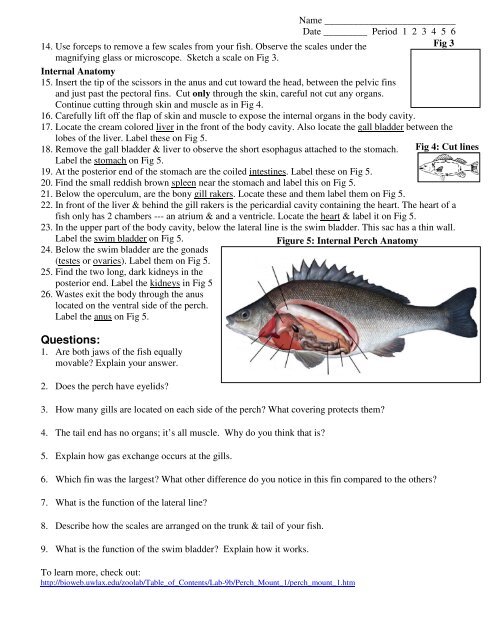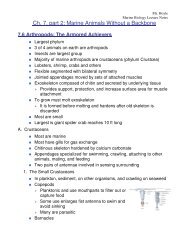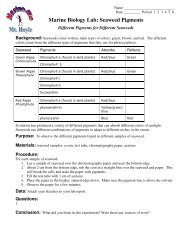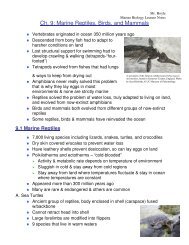Marine Biology Lab: Fish Dissection
Marine Biology Lab: Fish Dissection
Marine Biology Lab: Fish Dissection
You also want an ePaper? Increase the reach of your titles
YUMPU automatically turns print PDFs into web optimized ePapers that Google loves.
Name ___________________________<br />
Date _________ Period 1 2 3 4 5 6<br />
14. Use forceps to remove a few scales from your fish. Observe the scales under the<br />
Fig 3<br />
magnifying glass or microscope. Sketch a scale on Fig 3.<br />
Internal Anatomy<br />
15. Insert the tip of the scissors in the anus and cut toward the head, between the pelvic fins<br />
and just past the pectoral fins. Cut only through the skin, careful not cut any organs.<br />
Continue cutting through skin and muscle as in Fig 4.<br />
16. Carefully lift off the flap of skin and muscle to expose the internal organs in the body cavity.<br />
17. Locate the cream colored liver in the front of the body cavity. Also locate the gall bladder between the<br />
lobes of the liver. <strong>Lab</strong>el these on Fig 5.<br />
18. Remove the gall bladder & liver to observe the short esophagus attached to the stomach. Fig 4: Cut lines<br />
<strong>Lab</strong>el the stomach on Fig 5.<br />
19. At the posterior end of the stomach are the coiled intestines. <strong>Lab</strong>el these on Fig 5.<br />
20. Find the small reddish brown spleen near the stomach and label this on Fig 5.<br />
21. Below the operculum, are the bony gill rakers. Locate these and them label them on Fig 5.<br />
22. In front of the liver & behind the gill rakers is the pericardial cavity containing the heart. The heart of a<br />
fish only has 2 chambers --- an atrium & and a ventricle. Locate the heart & label it on Fig 5.<br />
23. In the upper part of the body cavity, below the lateral line is the swim bladder. This sac has a thin wall.<br />
<strong>Lab</strong>el the swim bladder on Fig 5.<br />
Figure 5: Internal Perch Anatomy<br />
24. Below the swim bladder are the gonads<br />
(testes or ovaries). <strong>Lab</strong>el them on Fig 5.<br />
25. Find the two long, dark kidneys in the<br />
posterior end. <strong>Lab</strong>el the kidneys in Fig 5<br />
26. Wastes exit the body through the anus<br />
located on the ventral side of the perch.<br />
<strong>Lab</strong>el the anus on Fig 5.<br />
Questions:<br />
1. Are both jaws of the fish equally<br />
movable? Explain your answer.<br />
2. Does the perch have eyelids?<br />
3. How many gills are located on each side of the perch? What covering protects them?<br />
4. The tail end has no organs; it’s all muscle. Why do you think that is?<br />
5. Explain how gas exchange occurs at the gills.<br />
6. Which fin was the largest? What other difference do you notice in this fin compared to the others?<br />
7. What is the function of the lateral line?<br />
8. Describe how the scales are arranged on the trunk & tail of your fish.<br />
9. What is the function of the swim bladder? Explain how it works.<br />
To learn more, check out:<br />
http://bioweb.uwlax.edu/zoolab/Table_of_Contents/<strong>Lab</strong>-9b/Perch_Mount_1/perch_mount_1.htm





